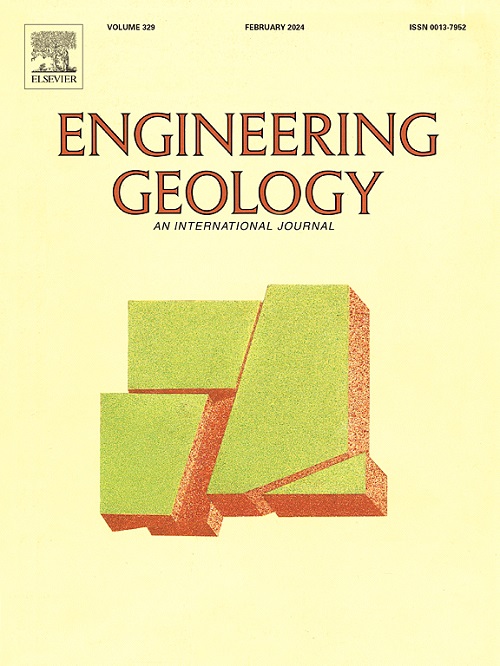两种典型地层结构中黄土滑坡的渗透性特征、结构破坏特征和触发过程
IF 8.4
1区 工程技术
Q1 ENGINEERING, GEOLOGICAL
引用次数: 0
摘要
发生在地层界面的滑坡是中国最常见的黄土滑坡形式之一。据统计,黑方台地层因灌溉诱发的黄土-红色淤泥质粘土界面滑坡比泾阳南地层的黄土-页岩界面滑坡严重。为了揭示两种典型地层结构的渗透性特征、结构破坏模式和诱发过程。本研究采用核磁共振(NMR)和扫描电子显微镜(SEM)技术研究了黄土-红色淤泥质粘土和黄土-页岩两种土壤组合类型的渗透性和结构破坏。结果表明,滞水效应与流速呈正相关,但与初始含水量呈负相关。值得注意的是,这两种典型地层的滞水效应存在明显差异。在黄土-红色淤泥质粘土中,细小粘土颗粒不断填充中孔和大孔隙,同时界面上的团聚体解体,从而增强了滞水效应。相比之下,黄土-页岩溶胶界面上的镶嵌孔隙之间具有良好的连通性。这有利于形成一些细长的微裂缝,这些微裂缝成为渗透的主要通道,削弱了积水效应。然而,黄土-红色淤泥质粘土和黄土-古溶胶组合地层中黄土滑坡的宏观触发机制仍然相似。灌溉水滞留在相对不透水的地层中,使黄土层底部饱和并造成结构破坏,最终诱发滑坡。这些发现为今后研究不同地层结构的黄土滑坡危害提供了科学依据,具有重要意义。本文章由计算机程序翻译,如有差异,请以英文原文为准。
Permeability characteristics, structural failure characteristics, and triggering process of loess landslides in two typical strata structures
Landslides occurring at the interface of strata are among the most common forms of loess landslides in China. Statistics indicate that significant loess-red silty clay interface landslides induced by irrigation in the Heifangtai Platform than loess-paleosol interface landslides in the South Jingyang Platform. To uncover the permeability characteristics, structural failure patterns, and triggering processes of two typical strata structures. This study employs Nuclear Magnetic Resonance (NMR) and Scanning Electron Microscopy (SEM) techniques to investigate the permeability and structural failure of two soil combination types: loess-red silty clay and loess-paleosol. The results revealed a positive correlation between the stagnant water effect and flow rate, but a negative correlation with the initial water content. Notably, these two typical strata exhibited distinct differences in the stagnant water effect. In loess-red silty clay, continuous filling of mesopores and macropores by fine clay particles, while at the same time the agglomerates disintegration at the interface, thereby enhancing the stagnant water effect. In contrast, loess-paleosol exhibited good connectivity between the mosaic pores at the interface. This facilitated the formation of several elongated microcracks, which acted as dominant channels for infiltration and weakened the stagnant water effect. However, the macroscopic triggering mechanism for loess landslides in both loess-red silty clay and loess-paleosol combination strata remains similar. Irrigation water stagnates within the relatively impermeable layers, saturating and structurally damaging the bottom of loess layer, ultimately inducing landslides. These findings provide a scientific basis for the future study of loess landslide hazards in different strata structures, which is of great significance.
求助全文
通过发布文献求助,成功后即可免费获取论文全文。
去求助
来源期刊

Engineering Geology
地学-地球科学综合
CiteScore
13.70
自引率
12.20%
发文量
327
审稿时长
5.6 months
期刊介绍:
Engineering Geology, an international interdisciplinary journal, serves as a bridge between earth sciences and engineering, focusing on geological and geotechnical engineering. It welcomes studies with relevance to engineering, environmental concerns, and safety, catering to engineering geologists with backgrounds in geology or civil/mining engineering. Topics include applied geomorphology, structural geology, geophysics, geochemistry, environmental geology, hydrogeology, land use planning, natural hazards, remote sensing, soil and rock mechanics, and applied geotechnical engineering. The journal provides a platform for research at the intersection of geology and engineering disciplines.
 求助内容:
求助内容: 应助结果提醒方式:
应助结果提醒方式:


